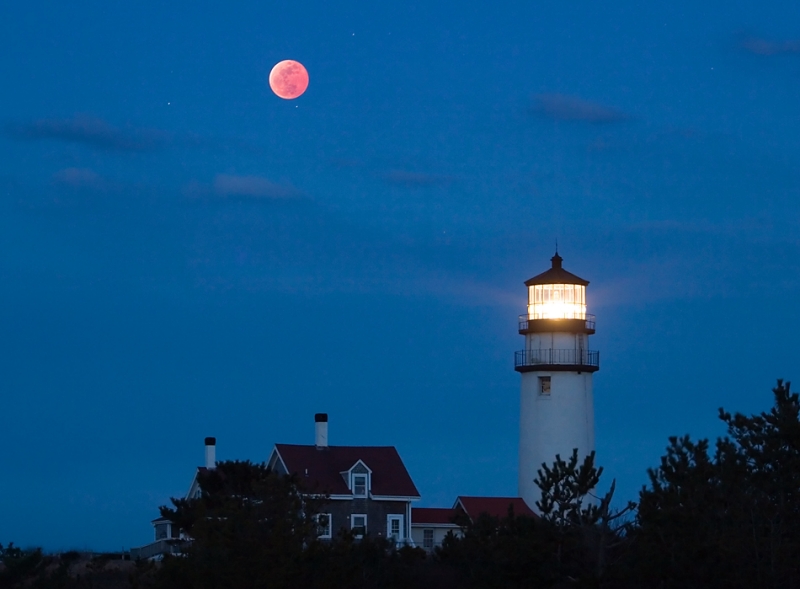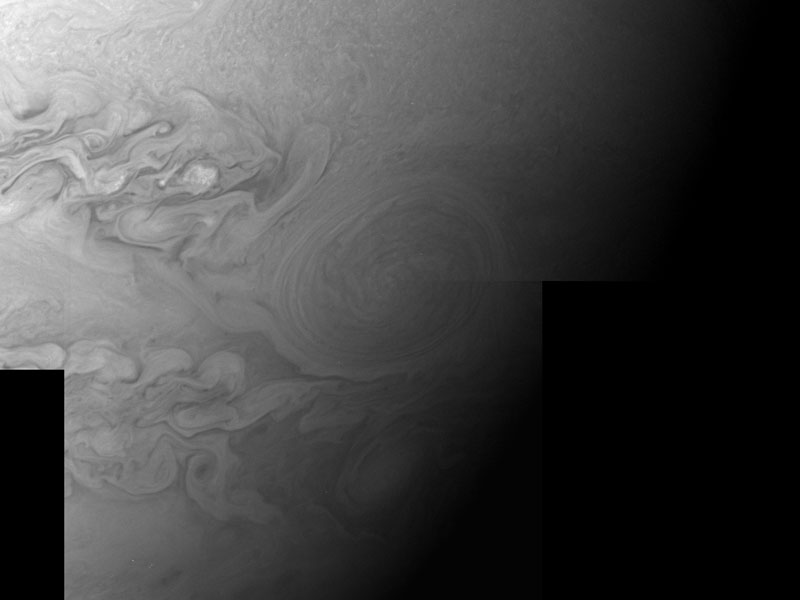 A Blue Crescent Moon from Space (4.03) In July 2006, the crescent moon was captured here from space. The moon appears blue due to the Earth's atmosphere because air molecules scatter blue light more easily. part of the moon appears to fade away because the moonlight is being reflected by the air molecules. The higher the space, the more it fades to black. This was taken from the International Space Station.
A Blue Crescent Moon from Space (4.03) In July 2006, the crescent moon was captured here from space. The moon appears blue due to the Earth's atmosphere because air molecules scatter blue light more easily. part of the moon appears to fade away because the moonlight is being reflected by the air molecules. The higher the space, the more it fades to black. This was taken from the International Space Station.
 Eclipse with Lighthouse (4.02) On March 3rd, a red moon of a total lunar eclipse rose over Cape Code, MA. This is from the Highland (cape Code) Lighthouse that is 66ft tall and was built in 1857. Normally two eclipses can be seen every year at this view.
Eclipse with Lighthouse (4.02) On March 3rd, a red moon of a total lunar eclipse rose over Cape Code, MA. This is from the Highland (cape Code) Lighthouse that is 66ft tall and was built in 1857. Normally two eclipses can be seen every year at this view.
 New Horizons Spacecraft Passes Jupiter (4.01) The New Horizons Spacecraft was launched in 2006 but just passed Jupiter. Using Jupiter's gravity, it will propell itself to pass Pluto (THE PLANET!) in 2015. While passing Jupiter, it captured its Little Red Spot and its ever-changing atmosphere. The Little Red Spot almost became part of the Great Red Spot after a few years of storms. This image shows that Jupiter's diameter is over twice of Earth's.
New Horizons Spacecraft Passes Jupiter (4.01) The New Horizons Spacecraft was launched in 2006 but just passed Jupiter. Using Jupiter's gravity, it will propell itself to pass Pluto (THE PLANET!) in 2015. While passing Jupiter, it captured its Little Red Spot and its ever-changing atmosphere. The Little Red Spot almost became part of the Great Red Spot after a few years of storms. This image shows that Jupiter's diameter is over twice of Earth's.
March 2, 2007
delta Orionis: 2.7
zeta Orionis: 1.8
gamma Orionis: 2
eta Aurigae: 3.3
beta Tauri: 1.5
beta Eridani: 1.7
alpha Canis Majorum: -1.2
eta Canis Majorum: 2
mu Geminorum: 3
xi Geminorum: 3.5
alpha Geminorum: 1.8
 Atmospheres Detected for Two Extrasolar Planets (3.08)The Spitzer Space Telescope tried to detect water vapour in atmospheres of plantes besides Earth but could not detect any traces. Using infrared light, it observed HD 209458b and HD 189733b. Light emitting gasses were being blocked during eclipsing. Had water been present in these gasses, life on other plantes would have been possible. This is an artistic rendition.
Atmospheres Detected for Two Extrasolar Planets (3.08)The Spitzer Space Telescope tried to detect water vapour in atmospheres of plantes besides Earth but could not detect any traces. Using infrared light, it observed HD 209458b and HD 189733b. Light emitting gasses were being blocked during eclipsing. Had water been present in these gasses, life on other plantes would have been possible. This is an artistic rendition.



